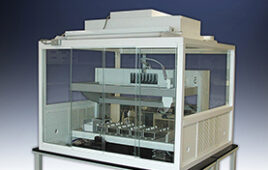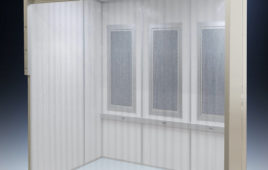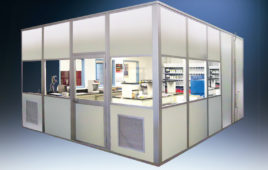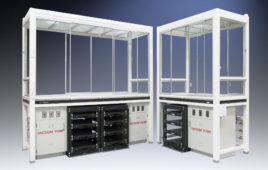WHAT IS CORROSION?
Corrosion happens. It is a natural process in that the oxide of a metal is at a lower energy state than either the pure metal or an alloy. While eternal corrosion elimination is not a realistic goal, effective corrosion control can forestall the process. The timeline required for forestalling corrosive effects variesmarkedly. It may be years, as in the useful lifetime of a finished product. It may be minutes, enough time to transfer a sub-assembly from a critical cleaningto a coating process.
Corrosive products may be grossly visible, especially as a result of unchecked corrosion processes (Figure 1). However, sometimes the first subtle indications of corrosive products are detectable by sophisticated techniques (Figure 2), providing an early warning opportunity for process intervention.

Figure 1. Corrosion of auto parts in a seaside
dump (Glass Beach, Ft. Bragg, CA)

Figure 2. Atomic Force Microscopy of onset of cor-
rosion of Al (courtesy Dr. B. Bavarian, CSUN)
CONSEQUENCES
Corrosion has an enormous economic impact. The total annual direct costs of corrosion are estimated at nearly $300 billion in the U.S. alone (over 3% of the GNP).1A similar amount is estimated for indirect, societal costs (e.g., lost time and productivity). Consequences of corrosion range from purely cosmetic effects (the surface does not maintain an attractive finish) topremature product failure, frequently from loss of strength.
Corrosion can contribute to contamination. Avoiding corrosion is an essential part of industrial and critical cleaning processes both in terms of the product surface and in terms of contamination control. In the manufacture and assembly of critical components, both in and out of the cleanroom, corrosion products on the product or the tooling can produce an uneven surface that traps contamination.Removing entrapped corrosive products is difficult. In addition, the part canbe recontaminated by corrosive products on tooling or in process baths.

Figure 3. The corrosion “square”

Figure 4. Corrosion square with one
corner removed
CORROSION SQUARE
The “fire triangle” is used to illustrate that a fire needs fuel, an oxidizer, and an ignition source, and that to prevent fire, at least one of those three sources must be eliminated. Analogously, for corrosion, we canpicture a “corrosion square” (Figure 3) to denote four elements thatmust be present for corrosion to occur. The components of this square are:
1. An anodic area that supplies electrons
2. A cathodic area that consumes electrons
3. A conducting path between the anodic and cathodic areas
4. Oxygen or an oxidizing chemical
To forestall corrosion, we must eliminate of one or more components of this square (e.g., Figure 4).
CATEGORIES OF CORROSION
There are many sources of corrosion. Bookshelves can be filled with approaches to controlling and testing for corrosion and corrosive products. We will focus on some types of corrosion that can occur during fabrication and assemblyof critical components.
Galvanic
Galvanic corrosion occurs when metals are in electrical contact either by direct contact or via a conducting liquid. The different electric potentials of dissimilar metals cause a galvanic cell (a battery) with current flow (transfer of electrons). The anode, with a lower electrochemical potential, is more susceptible to corrosion than the cathode. The corrosion can be especially strong if the anodic area is small compared with the cathodic area. A galvaniccell can also occur, even with similar metals, when the constituents of the conductingliquid vary from location to location.
Microbial
Microbial corrosion can occur when living cells help create some of the pathways for corrosion. It is not really a different kind of corrosion but creates the same conditions as are found with other forms. We will treat this topic in greater depth in an upcoming column.
Crevice
When a localized situation exists, such as in a crevice, where oxygen can be consumed but not replenished, a galvanic cell is created and an accelerated anodic corrosion can occur. Examples of such situations are under gasketsor in threaded connectors.
Oxygen depletion is the most common but not the only mechanism than can cause corrosion in small spaces. Acidity or depletion of corrosion inhibitors can also lead to an accelerated rate of attack in small spaces and can result in pitting.2
Intergranular
The edges of grain boundaries in an alloy are somewhat more reactive than the matrix. In most cases, the difference is small and of little consequence, but there are some cases, usually as a result of improper heat treatment,where grain boundary corrosion can be of concern.3
Stress corrosion
Stress corrosion, a major cause of loss of strength in metals, is the result of a combination of mechanical stress and corrosive mechanisms. Due to stress, small cracks occur which are then magnified by crevice or intergranular corrosioneffects.
Selective leaching
Selective leaching occurs in alloys where one constituent of the alloy is removed more readily than another. The most common such situation is dezincificationof brass.
CONTROL
Corrosion is not rust; it is the process through which rust, a corrosive product, is produced. Controlling corrosion entails interrupting that process by removing one or more of the conditions constituting the corrosion square. This can be accomplished by specific surface preparation or modification, by coatings, and/or by control of the surrounding environment. Successful corrosion control is frequently the most challenging aspect of a manufacturing process. We will expand on methods of corrosion control in a subsequent column in thisseries.
Acknowledgement: The authors wish to thank Dr. Behzad Bavarian, California State University Northridge, for helpful discussions.
References:
1. “Corrosion Cost and Preventive Strategies in the United States” NACE report available at http://www.corrosioncost.com/downloads/pdf/index.htm
2. See for example http://httd.njuct.edu.cn/MatWeb/corrosie/c_pit.htm
3. P. Rothwell, “Corrosion Phenomena—An Introduction”, available at http://www.npl.co.uk/lmm/docs/introduction_to_corrosion_phenomena.pdf
Barbara Kanegsberg and Ed Kanegsberg are independent consultants in critical and precision cleaning,surface preparation,and contamination control.They are the editors of The Handbook for Critical Cleaning,CRC Press.Contact them at BFK Solutions LLC.,310-459-3614; [email protected];www.bfksolutions.com.




